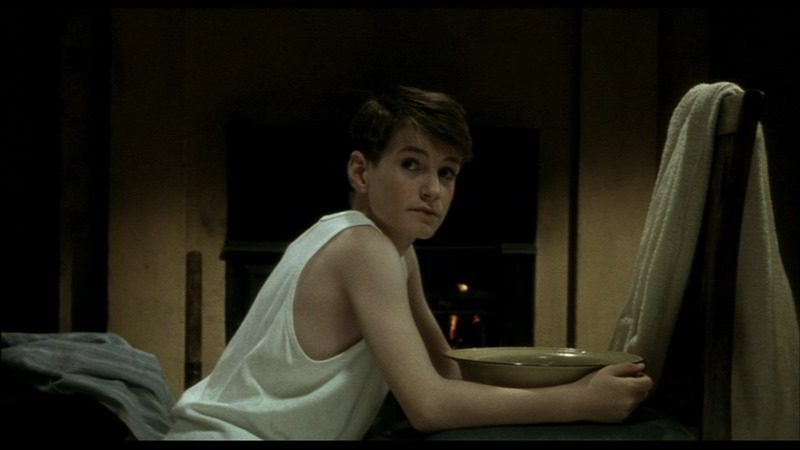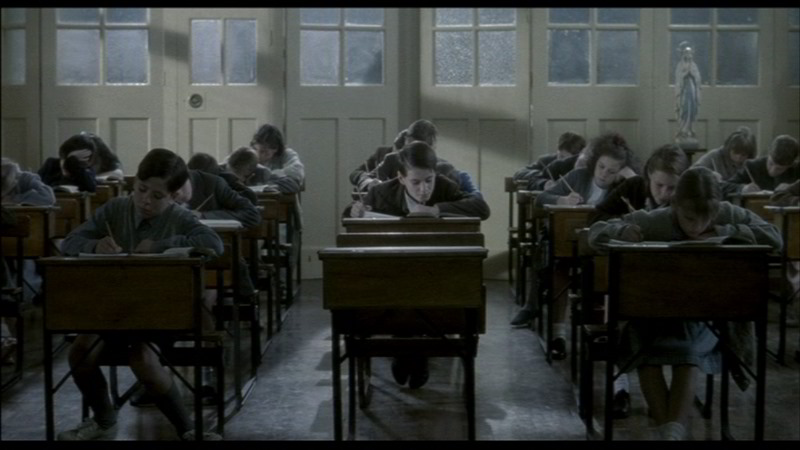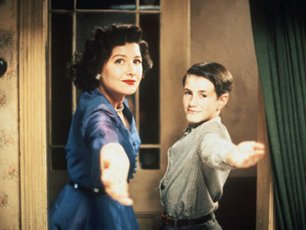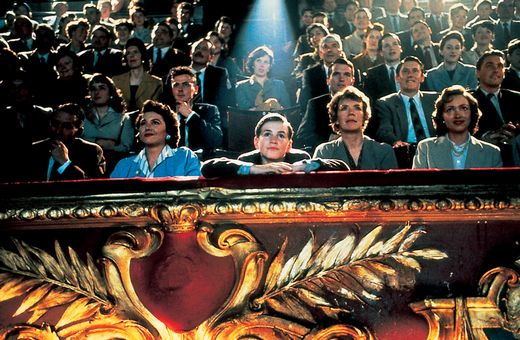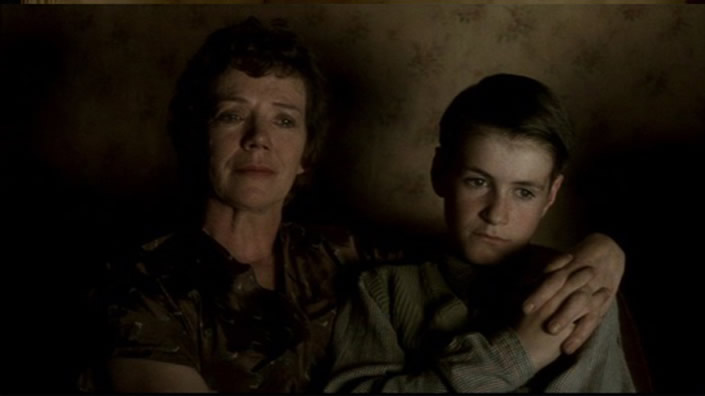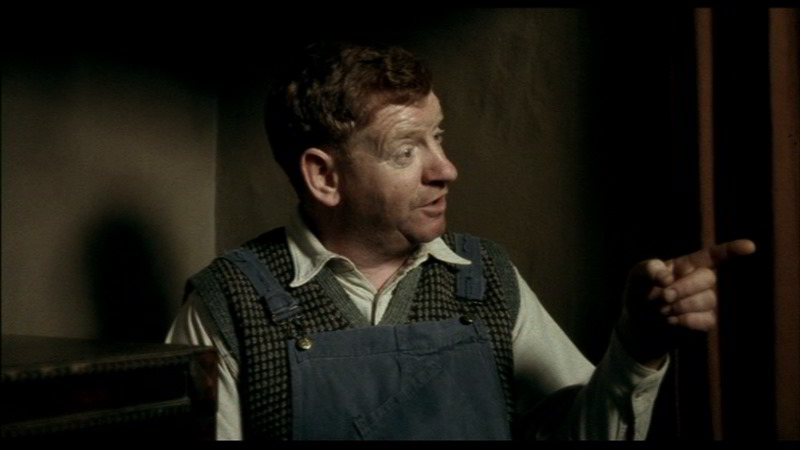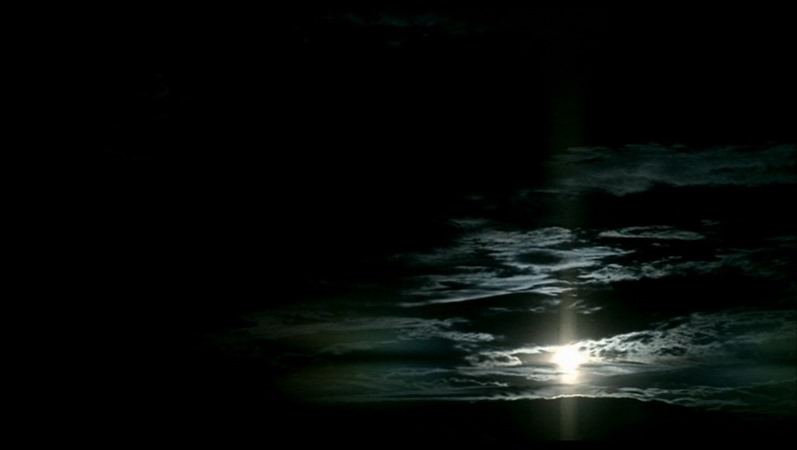This appeared in the Chicago Reader (July 30, 1993). –J.R.
THE LONG DAY CLOSES
**** (Masterpiece)
Directed and written by Terence Davies
With Leigh McCormack, Marjorie Yates, Ayse Owens, Nicholas Lamont, Anthony Watson, Tina Malone, and Jimmy Wilde.
I began making films [out of] a deep need . . . to come to terms with my family’s history and suffering, to make sense of the past and to explore my own personal terrors, both mental and spiritual, and to examine the destructive nature of Catholicism. Film as an expression of guilt, film as confession (psychotherapy would be much cheaper but a lot less fun). — Terence Davies
With The Long Day Closes English filmmaker Terence Davies completes his second autobiographical trilogy. (Faber and Faber has conveniently published the screenplays of the six films — all his films to date — with an introduction by Davies, under the title A Modest Pageant.) I haven’t seen the first trilogy — Children (1976), Madonna and Child (1980), and Death and Transfiguration (1983) — but the first two parts of the second, shot in 1985 and 1987 and distributed as a single feature, Distant Voices, Still Lives (1988), still strikes me as one of the greatest of all English films.
If The Long Day Closes — which I’ve seen only two times, ten months apart — seems somewhat less strong, it is still a masterpiece powerful enough to blow every other new movie currently playing in Chicago out of sight and out of mind. In one fell swoop it makes a summer of garbage seem blissfully irrelevant, restoring to cinema the sheer pleasure of sound and image that the warmed-over plots and Pavlovian commands of the “summer releases” can’t begin to approximate. Seeing and hearing this movie is tantamount to having one’s eyes and ears thoroughly cleaned. If the media seem predictably underwhelmed by this opportunity, it may be partly because critics have already squandered most of the apt terms for The Long Day Closes on the summer’s usual round of juvenile misogynistic and xenophobic thrillers and smart-alecky comedies. Having read and heard over the past months that Reservoir Dogs, Cliffhanger, The Firm, and In the Line of Fire are all about “redemption,” what sense does it make to say that The Long Day Closes is about redemption too? It’s rather like saying that Jurassic Park, Last Action Hero, Sleepless in Seattle, Another Stakeout, and Handel’s Messiah all traffic in transcendental enlightenment.
Davies has stated that The Long Day Closes is the last autobiographical film he intends to make — he is currently planning to direct an adaptation of the late John Kennedy Toole’s The Neon Bible in the United States — but it’s worth pointing out that for him autobiography has always involved a certain amount of poetic license. He was born in Liverpool in 1945, and while Children begins with a boy much like himself in the late 50s, Death and Transfiguration ends with the same character as an old man, dying alone in a geriatric ward. (A similar–and similarly painful–trajectory is traced in Davies’s hard-to-come-by 1984 novel, Hallelujah Now, also divided into three sections, which deals in part with his agonies as a shy and guilt-ridden homosexual with masochistic tendencies.) Distant Voices, Still Lives is largely based on family events Davies learned about secondhand, from his mother and older siblings — mainly relating to his brutal father, who died when he was seven. And The Long Day Closes, which covers his life in Liverpool between the ages of 7 and 11, compresses all its events into two years, 1955 and 1956. “Whole periods of time are elided into a few seconds of screen time,” Davies has said of his films, “while other moments, insignificant in themselves, are expanded into whole sequences.”
Though the same actors are used in both sections of Distant Voices, Still Lives, different actors and different names are used for the same characters in The Long Day Closes. The locations, however, are similar (if not identical): both features are set in the same desolate, dingy working-class house and Liverpool neighborhood. Davies’s surrogate is named Tucker in his first trilogy and Bud in The Long Day Closes; in Distant Voices, Still Lives he has no surrogate.
Like most of the best autobiographies, The Long Day Closes reworks the past rather than merely re-creating it, and it doesn’t require us to share its author’s preoccupations and reference points to give pleasure. Though the film’s key experiences are transitions — Bud (Leigh McCormack) going from primary school to secondary school, discovering the first flickers of sexual desire, and transferring some of his worshipful feelings from Catholicism to commercial movies — continuity is as much a part of these transitions as rupture. The film’s articulations of these complex processes are above all musical; only secondarily do they qualify as narrative, and they’re far more emotional than intellectual. The drama and the “story” arise as if of their own accord from the orchestration of characters, places, memories, and themes, but the film’s itinerary can never be reduced to a simple linear plot.
This is another reason most of the media — including supposedly “serious” publications like the New Yorker — feel ill at ease with such a movie, preferring just about any hackneyed plot to a piece of cinema without a paraphrasable story. Similarly, some reviewers have argued that the absence of the brutal father figure in The Long Day Closes means a certain loss in dramatic tension compared to Distant Voices, Still Lives. I can see what they mean, but only if drama and tension are defined solely in terms of character and incident. If consciousness itself is the subject of The Long Day Closes, as I believe it is, then there’s very little drop in feeling and intensity.
Because describing the experience of this film is so difficult, I’d like to start off with a few observations rather than the usual narrative rundown. What are Davies’s principal devices? Here are a few just for starters:
There are elaborate, choreographed camera movements ranging from lateral tracks to semicircular pans to spiral cranes. We hear 30 separate pieces of music, ranging from Mahler to pop records to choral hymns to musical-comedy numbers to pub sing-alongs to the 20th Century-Fox theme, and sound clips featuring dialogue or narration from seven English and Hollywood features, among them The Ladykillers, Kind Hearts and Coronets, The Magnificent Ambersons, and Meet Me in St. Louis. (The sound clips are mainly used thematically rather than as period references: Orson Welles’s nostalgic evocations of upper-class midwestern life provide an ironic gloss on Davies’s equally fond but more drab recollections.)
There are lighting changes that signal the passage of time (a carpet pattern seen at different times of day) and transitions into and out of Bud’s daydreams. (Seated at his desk in the center of a classroom, lit by a spotlight, he looks out the window and sees a huge ship sailing past, gets sprayed with wind and rain, then is seen dry as the other boys in the surrounding desks become visible again.) There are recurring architectural motifs — windows are as important here as doors were in Distant Voices, Still Lives — and recurring postures. (Looking out various windows in his house, Bud often kneels on the floor, which recalls his prayers in church and his rapt leaning against the parapet in a movie theater balcony.)
Other images merge or develop. A bare-chested bricklayer who smiles and winks at Bud in an early scene reappears several times as a crucified Christ in various fantasies and in one abrupt nightmare. The sounds and images of rain recur in countless ways — Davies does wonders with watery shadows on walls and ceilings. In one memorable scene set near an indoor swimming pool, the sound alerts us to the setting before we see the water.
There’s a deliberately ugly moment — the closest thing to social commentary I’ve seen in Davies’s work — when a polite, well-dressed Jamaican black man appears at the front door of the house, looking for a similar address, and everyone responds to him with fear and hostility. There’s a beautifully surreal moment when a door opens on a family Christmas gathering with everyone facing the camera, and interior elements (the Christmas tree and cake) and exterior ones (street lamp and falling snow) are uncannily combined, as if in a dream. There’s also a very entertaining character named Curly (Jimmy Wilde) who loves to irritate his wife Edna (Tina Malone) by doing imitations of Hollywood actors.
One problem with inventories is that they suggest a formless succession of “beautiful moments,” when The Long Day Closes is anything but that; indeed, the careful placement of each moment is essential to this film’s beauty. If Sergei Eisenstein’s quip about Russian formalist Viktor Shklovsky’s writing — “a string of pearls without the string” — seems applicable here, it’s only because most of us are so hooked on a single kind of string called narrative. We still have to learn how to identify and describe other kinds — emotional, thematic, visual, and musical, among others — that can work independently of a story. The love between Bud and his mother (Marjorie Yates) is one such string in this movie; thematic continuities between classroom, church, and movie theater are another. The movement of thought itself is what composes the “action,” but it’s not the kind of thought that can be translated into prose; the film thinks in sounds and images.
Orchestrating sounds and images to convey the elusive movement of thought isn’t of course unique to Davies, however unusual it may be in the context of other new movies. One also finds this sort of poetry in the hero’s walk across the marshes to keep his rendezvous with the City Woman in F.W. Murnau’s Sunrise (1927) — above all when the camera suddenly darts past him to arrive at his destination before he does, and by a separate route. Other supreme examples include the angular compositions-in-motion of Eisenstein’s Ivan the Terrible (the first part of which is playing at the Film Center this week), the extraordinary camera movement around a self-styled prophet and a little girl in Carl Dreyer’s Ordet (with the camera and the crab dolly on which it’s mounted moving eerily in opposite directions), certain montage sequences in Alain Resnais’ Last Year at Marienbad and Chris Marker’s Sans soleil, and some of the backward and forward tracking shots in Welles’s Citizen Kane, The Magnificent Ambersons, and Mr. Arkadin. Though it would be foolish to rank Davies within this august company — at this level of achievement such discriminations are relatively meaningless — I still think his work merits inclusion in this category, and there are very few filmmakers of this sort at present who show comparable mastery.
One of the climactic sequences in The Long Day Closes beautifully illustrates Davies’s method. One Sunday afternoon, over the concluding strains of a BBC comedy radio show, Bud’s older siblings ride away on bicycles, leaving the street in front of his house empty. Bud walks down the steps and turns left, trailing his hand across the iron fence. Arriving at the top of the steps leading to the cellar, which the camera views from an overhead angle, he grabs hold of an iron bar stretching from the house to the fence and begins to swing back and forth on it over the steps. We begin to hear Debbie Reynolds sing “Tammy” from the 50s movie Tammy and the Bachelor, which plays over the remainder of the sequence.
The camera cranes away from Bud and back to the doorstep, and the image dissolves to an overhead shot tracking past a large movie theater audience, moving from the projection booth toward the screen as Bud and his mother walk down the smoky aisle at screen center, beneath the projector’s beam, to find their seats. There’s a match cut to a similarly positioned camera movement over people kneeling in church, and over the strains of “Tammy” we hear a brief sound clip from Kind Hearts and Coronets. That’s succeeded by another sound clip from another English comedy, Private’s Progress, over another match cut to a camera movement over schoolboys at their desks; following their teacher’s instructions, they get up and file out of the room, moving in the same direction as the camera. Finally we return via another match cut and overhead crane to the bar over the cellar steps, this time without Bud, and the camera movement finally stops. We next see Bud looking out the window at the street.
This sequence differs in several respects from the account given in Davies’s script, suggesting that he’s as creative in the realization of his ideas as he is in their conception. The connections between movie theater, church, and classroom are only one part of the voluptuous thought being expressed; we also move from a theater being filled to a classroom being emptied, and from a boy playing in a dank location to that same location without him. But calling this sequence deeply religious or asserting that “Tammy” carries the full force of this religious feeling, as much as the luminous stripe of a projector beam over the heads of spectators and the serene drift of the camera along this placid river of light do, scarcely does justice to the passage’s poignant lyricism, the simultaneous feelings of exaltation and loss it evokes — none of which would have been expressed if Davies had rationalized these feelings into a story line. Even with the two sound clips from English comedies, nothing feels cluttered or top-heavy; the fluidity of thought and feeling is breathtaking, creating a sustained revery of ecstatic revelation. Perhaps we could speak of redemption, too, if Stallone, Cruise, and Eastwood hadn’t already cornered that busy market.



